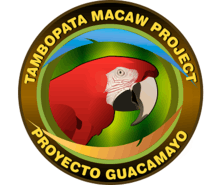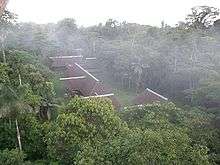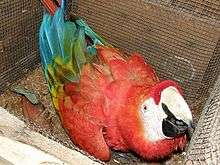Tambopata Macaw Project
 | |
| Formation | January 1, 1989 |
|---|---|
| Location | |
| Coordinates | 13°08′04″S 69°36′38″W / 13.1345°S 69.610667°WCoordinates: 13°08′04″S 69°36′38″W / 13.1345°S 69.610667°W |
Director | Dr. Donald Brightsmith |
Staff | 10 |
| Website |
www |
The Tambopata Macaw Project (Spanish: Proyecto Guacamayo de Tambopata) is a long term research project on the ecology and conservation of macaws and parrots in the lowlands of south-eastern Peru under the direction of Dr. Donald Brightsmith of the Schubot Exotic Bird Health Center at Texas A&M University. The project has been working with wildlife and local communities since 1989. The long term research and monitoring has provided many insights into various aspects of parrot and wildlife of south-eastern Peru. Macaws are among the most effective flagship species for ecosystem conservation in the Amazonian rainforest.
Location
The project is headquartered in the Tambopata Research Center (TRC) of Rainforest Expeditions situated in the Tambopata National Reserve on the upper Tambopata River in the center of a large uninhabited track of primary tropical lowland forest, very near to the Bahuaja-Sonene National Park, in the Madre de Dios Region of Peru.
The area hosts a unique forest environment, with the highest concentrations of avian clay licks in the world. A range of animals comes to satisfy their need for salt along the river banks of the region. Sometimes hundreds of macaws can be seen at the Collpa Colorado clay-lick near to the research center.

History
The project was established by Eduardo Nycander, a Peruvian nature enthusiastic and architect, with the goal of studying the ecology and natural history of large macaws so that this information could be used to help protect these birds throughout the tropics. In 1991 and 1992 the researchers accelerated the formation of natural dead palm cavities by cutting off the crowns of 23 live Mauritia flexuosa palms in a natural monoculture of thousands of these palms in a 0.5 km2 swamp near the Tambopata Research Center (TRC), as blue-and-yellow macaws almost exclusively nest in dead mauritia palms. Decapitating these palms began the process of rotting the interior of the trunks, which eventually provides nesting sites for these macaws.[1]
With the aim of providing nesting sites for large macaws in 1990, 24 palm nest boxes were made from Iriartea ventricosa palms.[2] The nests were hung 40–50 m above the ground in the branches of Dipteryx micrantha trees. In March 1992, 8 nest boxes were built from tropical cedar (Cedrela odorata) and hung. Between August–October 1992, 10 other artificial nests made from large PVC pipes were built and hung around TRC. In 1993 an additional 11 PVC nests were hung.

Based on growth rate data for more than 60 wild macaw nestlings in natural nests, researchers were able to plot growth curves for healthy nestlings and curves for nestlings that eventually died of malnutrition or disease. Once it was determined which nestlings probably would die, these nestlings were removed, handfed for months and released near TRC, thereby increasing the reproductive output of the wild population.[2] Between 1992-1994 breeding seasons a variety of methods of rescuing and hand-raising of otherwise doomed nestlings were tested at TRC. In the period of 1992-1995, 6 blue-and-yellow macaws (Ara ararauna), 5 red-and-green macaws (Ara chloropterus), and 21 scarlet macaws (Ara macao) were hand-raised and released into the wild population. These individuals later became called as “Chicos” (the kids). At this time TRC was only a 40x12 m building. These birds fledged and gradually integrated themselves into the wild macaw population.
The project has received substantial magazine and media coverage within Peru and internationally,[3] thanks to its volunteers, the visiting tourists, tour operators, journalists, photographers and filmmakers. In November 1999, Dr. Donald Brightsmith took over the research project and he is still the director. Thanks to his work a broad spectra of scientific research has been carried out at TRC.[4][5][6][7] Since 2006 the project’s leading patron is the Schubot Exotic Bird Health Center, College of Veterinary Medicine, Texas A&M University.
Research objectives
The principal aim of the Tambopata Macaw Project is to study the various aspects of the ecology of large macaws and parrots to help better understand the interactions among clay lick use, food supply, breeding season, breeding success, abundance, and movements.
A great interest to the project is that clay lick use by large macaws at TRC was very low in 2009 due to the changes in vegetation and soil conditions. However, in early 2010 the Peruvian government, together with the members of the research project managed the clay lick to help restore the large macaw usage. As a result, there is a unique opportunity to study the same populations of macaws both with and without clay lick use.
Another important aim of the project is to help train new generations of conservation scientists. As a result, the project works closely with young Peruvian and foreign assistants and helps them gain the skills they need for conducting research. Students interested in conducting their own independent studies as parts of independent study classes, or theses at the undergrad, M.Sc. or Ph.D. levels are encouraged to apply to study one of the many aspects of macaw and parrot biology at the sites.
Specific project objectives:
- Determine if food abundance or clay lick use is more closely tied to nest occupancy and nesting success.
- Determine if clay lick use is correlated with parrot abundance.
- Determine how large macaw nest success varies with relation to food supply and climate.
- Document the nutritional content of parrot foods in the forest to better understand the role of clay lick in the diet of macaws and parrots.
- Determine the health status of adult and young parrots to use this information to help manage parrots in captivity.
Current studies
The staff of the Tambopata Macaw Project monitors year round the clay-lick activity at the nearby Collpa Colorado, conducts parrot census in the forest, collects data on foraging of wild macaws, records climate data at TRC.
For more than a decade, the project is recording breeding biology data from large macaws by systematic way. This study is carried out during the reproductive season of the macaws between November–March, by climbing natural and artificial nests in the vicinity of TRC.
In 2008, with the support of Janice Boyd the project started a satellite telemetry study on captured macaws in the wild to investigate their home-range use and seasonal movements.
Extensive veterinary research is carried out during the breeding season on adult and young macaws under the direction of Dr. Sharman Hoppes from the Texas A&M University.
Gustavo Martinez is making his MSc thesis on phenology, interaction between climate, food availability and parrot abundance at TRC.
Gabriela Vigo from Texas A&M University is conducting her PhD research on mate and nest fidelity of scarlet macaws nesting around TRC.
The Tambopata faces imminent threat from the paving of a highway through one of the planet's most biodiverse regions. George Olah from The Australian National University is making his PhD study on the conservation genetics of large macaws in the region, determining population genetic trends and human impacts on the large macaw populations.
Ecotourism and voluntarism
The presence of macaws in an area destined for ecotourism in tropical America greatly increases its value.[8] The presence of clay-licks and nests where macaws are predictable and can be habituated to human presence increases the value of each macaw and therefore of the whole area.[2] Wild macaws habituate readily to noisy, exposed group of tourists and are excellent subjects for wildlife photographers. Over the past decade the project has worked closely with Rainforest Expeditions, an ecotourism company that hosts the project at their lodge, the Tambopata Research Center, and provides the project with salaries, donations, transportation, food, lodging, and logistics.[9]
The project also has attracted over 200 national and international volunteers, many of whom showed exceptional talent and are now associated with the project on an ongoing basis.[10] The project has been also serving as an effective mechanism to find and train talented young conservation professionals and activists.
References
- ↑ Brightsmith, D. and Bravo, A. (2006). Ecology and management of nesting blue-and-yellow macaws (Ara ararauna) in Mauritia palm swamps. Biodiversity and Conservation 15: 4271-4287.
- 1 2 3 Nycander, E., Blanco, D. H., et al. (1995). Manu and Tambopata: nesting success and techniques for increasing reproduction in wild macaws in southeastern Peru. Page: 423-443. In: The large macaws: their care, breeding and conservation. B. L. S. J. Abramson, & J. B. Thomsen, eds. Raintree Publications, Fort Bragg, California.
- ↑ Munn, C. A. (1994). Macaws: winged rainbows. National Geographic(185): 118-140.
- ↑ Brightsmith, D. and Aramburu, R. (2004). Avian geophagy and soil characteristics in Southeastern Peru. Biotropica 36(4): 534-543.
- ↑ Brightsmith, D. J. (2005). Parrot nesting in southeastern Peru: seasonal patterns and keystone trees. Wilson Bulletin 117: 296-305.
- ↑ Brightsmith, D. J., Taylor, J., et al. (2008). The roles of soil characteristics and toxin adsorption in avian geophagy. Biotropica 40(6): 766-774.
- ↑ Brightsmith, D. J. and Villalobos, E. M. (2011). Parrot Behavior at a Peruvian Clay Lick. The Wilson Journal of Ornithology 123(3): 595-602.
- ↑ Munn, C. A. (1992). Macaw biology and ecotourism, or “When a bird in the bush is worth two in the hand”. Page: 47-72. In: New World Parrots in Crisis: Solutions from Conservation Biology. S. R. Beissinger and Snyder, N. F. R., eds. Smithsonian Institution Press, Washington and London.
- ↑ Brightsmith, D. (2008). Rainforest Expeditions and Earthwatch as funding partners for Macaw (Ara spp.) research in Southeastern Peru. Ornitologia Neotropical(19): 173-181.
- ↑ Brightsmith, D., Stronza, A., et al. (2008). Ecotourism, conservation biology, and volunteer tourism: A mutually beneficial triumvirate. Biological Conservation 141(11): 2832-2842.